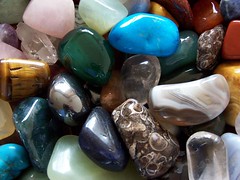
Gemstone Clarity
Here are ancient Vedic references from both the Garuda Puranam and the Agni Puranam v hich state emphatically that "flawed" gemstones are inauspicious, while "clean" gems are bringers of good fortune. Note: As they did not have high-powered microscopes in the ancient times it stands to reason that flawless means "eye-clean."
After 30 years of researching and experimenting with gemstones, it is our carefully considered _,pinion that the old Vedic texts are correct. Flawed gems are simply a source of misfortune, not to 3ention their being ugly! Think about it! How many people are prepared to tolerate "defects" in their clothing, or any other personal items which they possess. Even a single scratch on a nice automobile is an eye-sore, so why do people tolerate flawed gems? How can one read through cracked eye-glasses?
Think of a gemstone like a radio crystal. The crystal receives and transforms the invisible radio sound waves into audible sound. If the crystal is defective the sound will be distorted and unpleasant.
As stated before, gemstones are natural transmitters on Earth of Piezoelectric "astral" energy waves radiated from the Nava-graha or Nine planets recognized by the Vedic science of "sidereal" astrology. It is common sense that only "clean" gems will transmit "undisturbed" astral energy waves
At present, the gem trade has lost much of its integrity because of the widespread treatment of natural gems to conceal or "change" imperfections. Especially guilty are the emerald dealers who -oil" flawed gems as a routine procedure (the oil enters the gem through internal cracks which break the surface of the stone). The gold smith (and the owner) are unaware of the defective condition which often results in broken stones. Even if the stones make it past the setter, the oil will dry out in a few years and the "ugly" flaws will again become visible. This confuses the owner who may even think that the stone has been switched.
There ARE eye-clean, beautiful emeralds on this planet but they are scarce and costly. If one cannot afford the cost of an auspicious emerald then one can opt for an upa-ratna or "secondary gem." In place of emerald for the planet Mercury (Budha gnaha) one could use tsavorite (green grossularite), chrome-green or green tourmaline, chrome-green or green diopside, green peridot or greenjade. Jade, being an "aggregate" (made up of tiny crystals all fused together) is less preferable than the other Mercury gems which are "single unit" crystals.
Along with the Navaratna or nine "primary" gems, there are many other "natural" gemstone choices based on color. These "upa-ratnas" are less expensive than their precious counterparts and yet they conduct the same astral energy of their associated planet. They are
also easier to find without flaws or treatment.
Here is a list of the foremost upa-ratnas known to man, along with their ruling planets:
1) Red spinel, red garnet and red tourmaline (rubellite) are ruled by the Sun;
2) Moonstone and white coral are ruled by the Moon;
3) Yellow topaz, yellow beryl, yellow tourmaline and natural citrine are ruled by
Jupiter;
4) Orange zircon, spessartite and other orange garnets are ruled by Rahu;
5) Tsavorite, green tourmaline, diopside, peridot and green jadeite are ruled by
Mercury;
6) White (colorless) sapphire, white topaz, zircon and quartz are ruled by Venus;
7) Beryl, apatite and tourmaline cat's eyes are ruled by Ketu;
8) Blue spinel, iolite, blue tourmaline and amethyst are ruled by Saturn;
9) Carnelian and bloodstone are ruled by Mars
REMEMBER: Whatever gem(s) you use should be flawless, because according to ancient Vedic wisdom only "eye-clean" gems are helpful and attractive, while visibly flawed gems are defective and disturbing!
Having described in brief the individual nature and powers of the nine planetary gemstones along with the upa-ratnas (semiprecious gems), we will now elaborate on their preparation and use as astrological talismans.
1 comment:
That was very helpful. What about using Green Beryl for Mercury?
Post a Comment